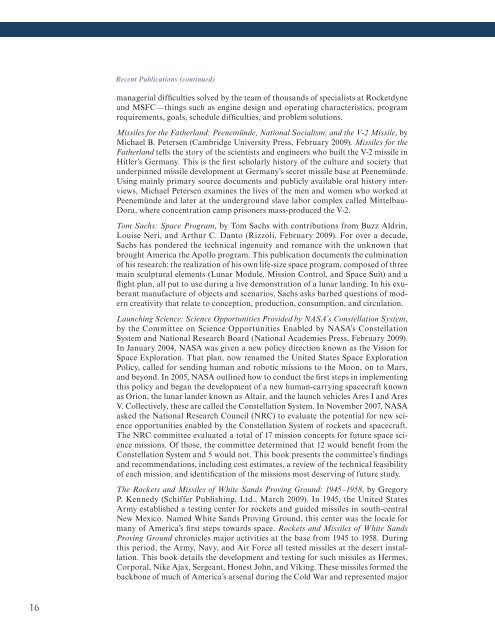FROM THE CHIEF HISTORIAN BORIS CHERTOK'S Rockets and ...
FROM THE CHIEF HISTORIAN BORIS CHERTOK'S Rockets and ...
FROM THE CHIEF HISTORIAN BORIS CHERTOK'S Rockets and ...
Create successful ePaper yourself
Turn your PDF publications into a flip-book with our unique Google optimized e-Paper software.
nasa history division<br />
16<br />
Recent Publications (continued)<br />
managerial diffculties solved by the team of thous<strong>and</strong>s of specialists at Rocketdyne<br />
<strong>and</strong> MSFC—things such as engine design <strong>and</strong> operating characteristics, program<br />
requirements, goals, schedule diffculties, <strong>and</strong> problem solutions.<br />
Missiles for the Fatherl<strong>and</strong>: Peenemünde, National Socialism, <strong>and</strong> the V-2 Missile, by<br />
Michael B. Petersen (Cambridge University Press, February 2009). Missiles for the<br />
Fatherl<strong>and</strong> tells the story of the scientists <strong>and</strong> engineers who built the V-2 missile in<br />
Hitler’s Germany. This is the frst scholarly history of the culture <strong>and</strong> society that<br />
underpinned missile development at Germany’s secret missile base at Peenemünde.<br />
Using mainly primary source documents <strong>and</strong> publicly available oral history interviews,<br />
Michael Petersen examines the lives of the men <strong>and</strong> women who worked at<br />
Peenemünde <strong>and</strong> later at the underground slave labor complex called Mittelbau-<br />
Dora, where concentration camp prisoners mass-produced the V-2.<br />
Tom Sachs: Space Program, by Tom Sachs with contributions from Buzz Aldrin,<br />
Louise Neri, <strong>and</strong> Arthur C. Danto (Rizzoli, February 2009). For over a decade,<br />
Sachs has pondered the technical ingenuity <strong>and</strong> romance with the unknown that<br />
brought America the Apollo program. This publication documents the culmination<br />
of his research: the realization of his own life-size space program, composed of three<br />
main sculptural elements (Lunar Module, Mission Control, <strong>and</strong> Space Suit) <strong>and</strong> a<br />
fight plan, all put to use during a live demonstration of a lunar l<strong>and</strong>ing. In his exuberant<br />
manufacture of objects <strong>and</strong> scenarios, Sachs asks barbed questions of modern<br />
creativity that relate to conception, production, consumption, <strong>and</strong> circulation.<br />
Launching Science: Science Opportunities Provided by NASA’s Constellation System,<br />
by the Committee on Science Opportunities Enabled by NASA’s Constellation<br />
System <strong>and</strong> National Research Board (National Academies Press, February 2009).<br />
In January 2004, NASA was given a new policy direction known as the Vision for<br />
Space Exploration. That plan, now renamed the United States Space Exploration<br />
Policy, called for sending human <strong>and</strong> robotic missions to the Moon, on to Mars,<br />
<strong>and</strong> beyond. In 2005, NASA outlined how to conduct the frst steps in implementing<br />
this policy <strong>and</strong> began the development of a new human-carrying spacecraft known<br />
as Orion, the lunar l<strong>and</strong>er known as Altair, <strong>and</strong> the launch vehicles Ares I <strong>and</strong> Ares<br />
V. Collectively, these are called the Constellation System. In November 2007, NASA<br />
asked the National Research Council (NRC) to evaluate the potential for new science<br />
opportunities enabled by the Constellation System of rockets <strong>and</strong> spacecraft.<br />
The NRC committee evaluated a total of 17 mission concepts for future space science<br />
missions. Of those, the committee determined that 12 would beneft from the<br />
Constellation System <strong>and</strong> 5 would not. This book presents the committee’s fndings<br />
<strong>and</strong> recommendations, including cost estimates, a review of the technical feasibility<br />
of each mission, <strong>and</strong> identifcation of the missions most deserving of future study.<br />
The <strong>Rockets</strong> <strong>and</strong> Missiles of White S<strong>and</strong>s Proving Ground: 1945–1958, by Gregory<br />
P. Kennedy (Schiffer Publishing, Ltd., March 2009). In 1945, the United States<br />
Army established a testing center for rockets <strong>and</strong> guided missiles in south-central<br />
New Mexico. Named White S<strong>and</strong>s Proving Ground, this center was the locale for<br />
many of America’s frst steps towards space. <strong>Rockets</strong> <strong>and</strong> Missiles of White S<strong>and</strong>s<br />
Proving Ground chronicles major activities at the base from 1945 to 1958. During<br />
this period, the Army, Navy, <strong>and</strong> Air Force all tested missiles at the desert installation.<br />
This book details the development <strong>and</strong> testing for such missiles as Hermes,<br />
Corporal, Nike Ajax, Sergeant, Honest John, <strong>and</strong> Viking. These missiles formed the<br />
backbone of much of America’s arsenal during the Cold War <strong>and</strong> represented major
















